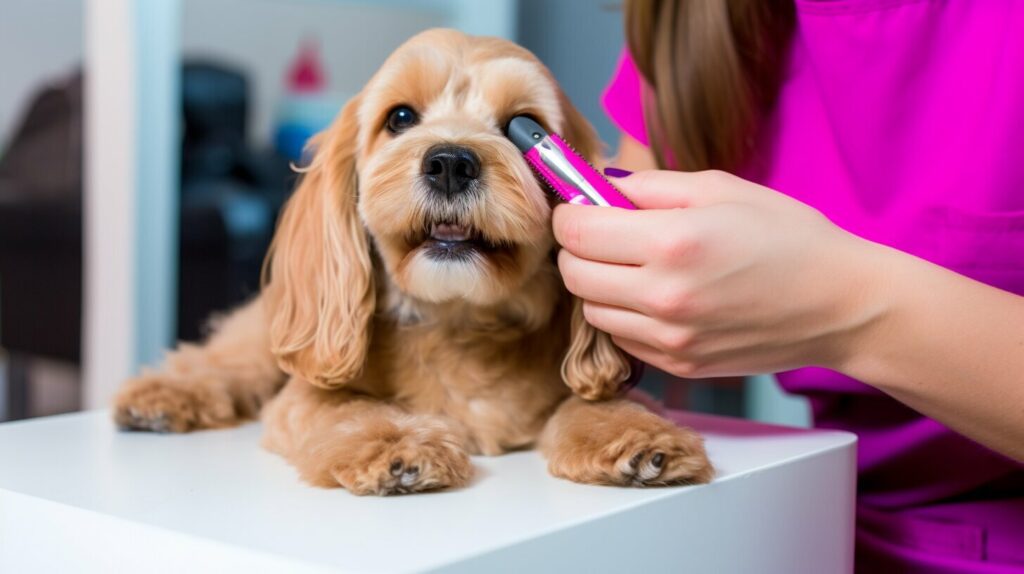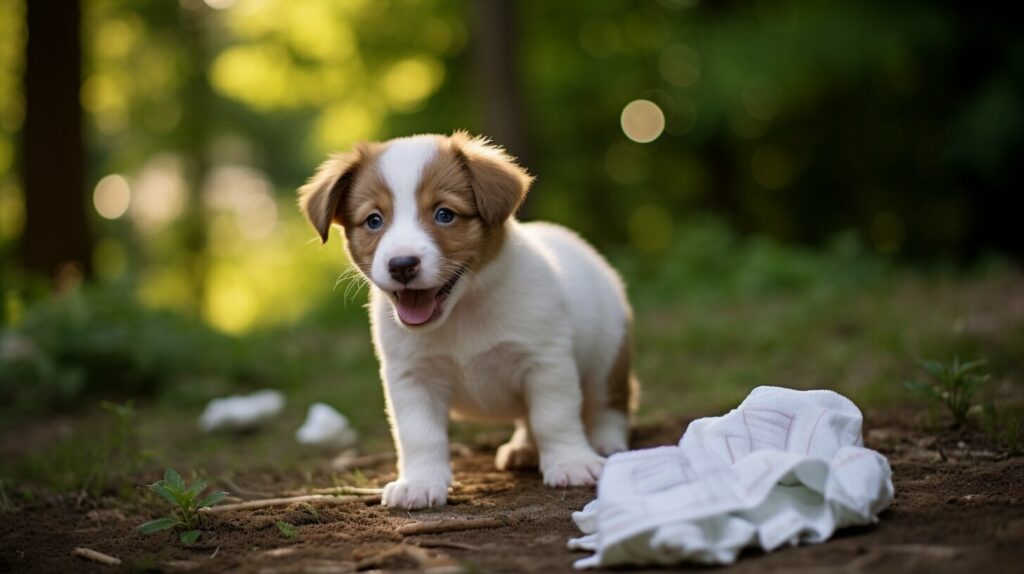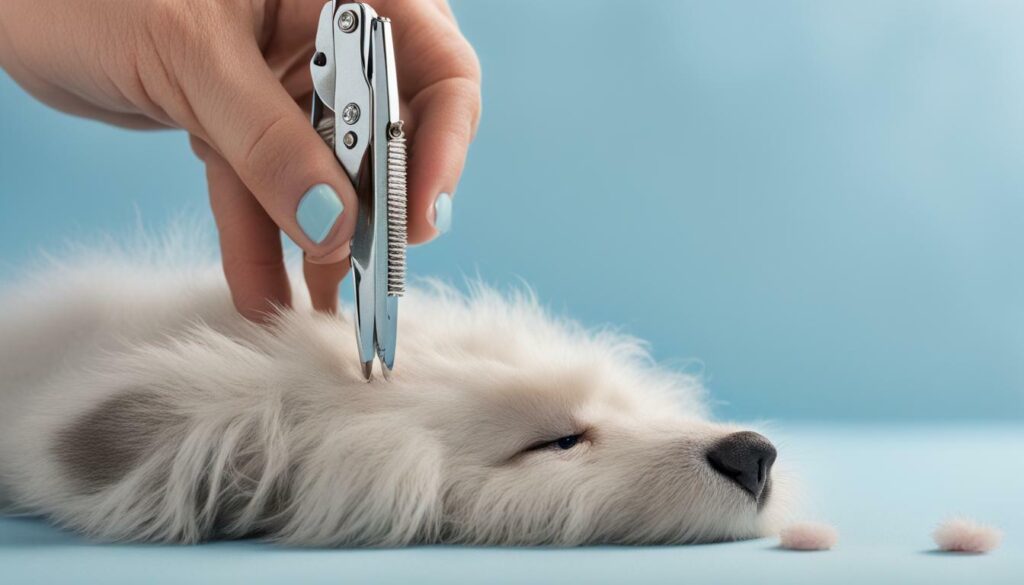If you’re a dog owner, you know how important it is to take care of your furry friend’s hygiene. Proper nail care is a crucial part of your dog’s grooming routine, and finding the right tools for the job can be a challenge. That’s why we’ve put together this comprehensive guide to help you choose the best nail clipper for dogs and provide expert tips for successful nail trimming at home.
Key Takeaways:
- Regular dog nail care is essential for maintaining optimal health and preventing discomfort and injury.
- Choosing the right nail clipper for your dog involves considering factors such as size, nail thickness, and personal preferences.
- Safely trimming your dog’s nails at home requires the proper tools, techniques, and precautions to avoid injury and discomfort.
Why Nail Trimming is Important for Dogs
As a responsible dog owner, you know how important it is to take care of your furry friend’s overall health and wellbeing. One aspect of dog care that is often overlooked is nail trimming. Neglecting your dog’s nails can lead to a host of health issues, discomfort, and pain.
Dogs‘ nails grow continuously, and if left untrimmed, they can become too long and pose a risk to the dog’s health. An overgrown nail can cause pain and even lead to infections, as dirt and bacteria can accumulate in the crevices beneath the nail. Additionally, overgrown nails can get caught in carpets, furniture, and other surfaces, causing the nail to split or break, leading to further pain and damage.
Trimming your dog’s nails regularly is vital for their overall health and hygiene. It ensures that the nails remain at an appropriate length, reducing the risk of any potential harm. It also helps to ease the discomfort your dog may feel when the nails are too long. By establishing a regular nail trimming routine, you can help your dog feel comfortable, happy, and healthy.
Choosing the Right Nail Clipper for Your Dog
When it comes to choosing the best nail clipper for your dog, there are several factors you should consider to ensure you get the right tool for the job. Using the wrong clipper can lead to discomfort or even injury to your furry friend.
Firstly, it’s important to consider the size of your dog. For larger dogs, you will need a clipper with larger blades to handle their thicker nails, while smaller dogs will require smaller blades.
The type of clipper you choose is also essential. There are three types of clippers to choose from: guillotine, scissors, and plier. Guillotine clippers are best suited for small dogs and have a hole where you insert the nail and a blade that slides across to cut the nail. Scissors clippers resemble human nail scissors and are better suited for medium to large dogs. Plier clippers operate similarly to scissors, but the blades are shaped like pliers, making them ideal for larger breeds.
Another crucial factor to consider is the comfort and safety of your dog. Look for clippers with non-slip handles to ensure a steady grip, reducing the risk of accidents. Some clippers also come with safety features like guards that prevent over-trimming and protect the quick, the sensitive part of the nail.
Lastly, consider your personal preferences, such as the design and brand of the clipper. Choose a clipper that you feel comfortable using and one that works well with your dog’s nail shape and size. Reading user reviews and expert recommendations can also help you make a well-informed decision.
Top Picks for Nail Clippers for Dogs
Choosing the right nail clipper for your dog can make a world of difference in the comfort and effectiveness of your nail trimming routine. Consider the size and thickness of your dog’s nails, as well as your personal preferences, when selecting a clipper. Here are our top picks for the best dog nail clippers:
| Nail Clipper | Recommended for: | Features: |
|---|---|---|
| Safari Professional Nail Trimmer | Large dogs |
|
| Millers Forge Quality Nail Clipper | All dogs |
|
| Boshel Dog Nail Clippers | All dogs |
|
| Andis Premium Large Nail Clipper | Large dogs |
|
These professional dog nail clippers are all great options for keeping your dog’s nails neat and tidy. Consider the size and thickness of your dog’s nails when selecting a clipper, and be sure to follow safety precautions when trimming. With the right clipper and technique, you can make nail trimming a stress-free and successful experience for you and your furry friend.
How to Safely Trim Your Dog’s Nails at Home
Trimming your dog’s nails can seem like a daunting task, but with the right tools and techniques, it can be a stress-free experience for both you and your furry friend. Before getting started, gather the necessary dog grooming tools, including a nail clipper suitable for your dog’s size and nail thickness.
Start by holding your dog’s paw firmly but gently, and examine the nail to determine where the quick ends and where trimming should occur. Note: The quick is the area of the nail that contains blood vessels and nerves, and cutting it can cause discomfort or bleeding.
Hold the nail clipper at a 45-degree angle and clip off a small portion of the nail, avoiding the quick. Repeat the process until you reach the desired length, keeping a close eye on the quick as it may be difficult to see with dark nails.
If your dog has light-colored nails, you can easily spot the quick as a pinkish area near the tip of the nail. However, for dogs with dark nails, you may need to use a flashlight to identify the quick.
Techniques for Anxious Dogs
If your dog is anxious or resistant to nail trimming, start by letting them get used to the nail clipper and the process. Offer treats and positive reinforcement to create a positive association.
You can also try massaging your dog’s paw and desensitizing them to the touch before beginning the nail trimming process. If your dog continues to resist, consider seeking professional dog grooming services or consulting with a veterinarian.
Remember to take your time, be patient, and stay calm during the nail trimming process. With practice and patience, you and your dog can have successful nail trimming sessions at home.
Tips for Successful Nail Trimming Sessions
Trimming your dog’s nails can be a challenging task, but it doesn’t have to be. Here are some tips to help make the process more successful:
- Schedule regular nail trimming sessions: Set a consistent schedule for trimming your dog’s nails. This will help maintain proper nail length and make the process more manageable.
- Use high-quality, sharp nail clippers: Invest in a quality nail clipper that is designed for your dog’s size and nail thickness. Dull or inefficient clippers can cause discomfort and injury for your dog.
- Be patient and calm: Approach nail trimming sessions with a calm, patient demeanor. Dogs can sense anxiety and stress, so maintaining a relaxed environment can help prevent resistance and discomfort.
- Work in a well-lit area: Choose a well-lit area to trim your dog’s nails to ensure visibility and reduce the risk of injury.
- Avoid cutting the quick: The quick is the sensitive part of a dog’s nail that contains blood vessels and nerves. Cutting the quick can cause pain and bleeding. If you’re unsure where the quick is located, seek advice from a professional groomer or veterinarian.
- Offer treats and positive reinforcement: Reward your dog with treats and praise during and after nail trimming sessions. This will help create a positive association with the experience and encourage cooperation in the future.
Dealing with Anxious Dogs
If your dog is anxious or resistant to nail trimming sessions, there are some additional steps you can take:
- Desensitization training: Gradually introduce your dog to the nail trimming process over time. This can involve handling their paws and introducing them to the clippers before attempting a full trim.
- Use calming aids: Calming aids such as pheromone sprays, calming collars, or natural remedies can help reduce anxiety in dogs.
- Seek professional help: If you’re unsure how to handle your dog’s resistance or anxiety, seek advice from a professional groomer or veterinarian.
Alternatives to Nail Clippers for Dogs
While nail clippers are a common and effective tool for dog nail maintenance, there are other options available for those who may prefer a different approach. Here are some alternatives to consider:
- Pet Nail Grinders: These tools use a rotating head to file down a dog’s nails gradually. They can be useful for dogs with thick nails or those who are fearful of clippers. However, they may take longer to use than clippers and require regular charging or battery replacement.
- Nail Files: Similar to human nail files, these can be used to smooth down jagged or sharp edges on a dog’s nails. They can be a good option for touch-ups between clipping sessions but may not be suitable for dogs with long nails.
- Professional Grooming Services: Many pet salons and grooming facilities offer nail trimming services as part of a full grooming package. These services can be convenient for owners who prefer to leave the task to professionals or who have dogs with particularly stubborn nails. However, they can be costly and may require booking in advance.
It’s important to remember that regardless of the tool/method chosen, regular nail maintenance is crucial for your dog’s health and comfort. Consult with your veterinarian or a professional groomer if you are unsure about the best approach for your dog’s individual needs.
Precautions and Safety Measures for Nail Trimming
As you prepare to trim your dog’s nails, there are several precautions and safety measures you should keep in mind to ensure a safe and stress-free experience for both you and your furry friend.
| Precaution | Explanation |
|---|---|
| Choose the Right Nail Clipper | Be sure to select a nail clipper that is appropriate for your dog’s size and nail thickness. Using the wrong type of clipper can cause pain or injury. |
| Trim Only the Tip | Trimming too much of the nail can cause bleeding and discomfort. Only trim the tip of the nail, leaving the quick (the part of the nail that contains blood vessels and nerves) intact. |
| Know Your Dog’s Limits | If your dog is anxious or resistant to nail trimming, take breaks and don’t push them too far. Quitting early and coming back to it later is better than risking injury or trauma. |
| Stay Calm and Confident | Dogs can sense when their owners are nervous or hesitant, which can exacerbate their anxiety. Stay calm, confident, and in control throughout the nail trimming process. |
| Watch for Signs of Discomfort | If your dog shows signs of discomfort, such as whimpering, pulling away, or licking their paws, stop immediately and check for injury or irritation. If necessary, seek veterinary care. |
Following these precautions and safety measures can help ensure a safe and successful nail trimming session with your furry friend. Remember to always prioritize your dog’s comfort and well-being, and seek professional help if you are unsure or uncomfortable with the process.
Maintaining Nail Health and Appearance
Regular dog nail care is crucial for maintaining the overall health and appearance of your pet’s nails. In addition to trimming them, there are other tips and techniques you can use to keep your dog’s nails in top shape. Below are some expert recommendations to help you maintain your dog’s nail health.
Frequency
The frequency at which you should trim your dog’s nails depends on how quickly they grow and how often they come into contact with hard surfaces. In general, most dogs require nail trimming every 1-2 months. However, larger dogs or dogs that are more active may require more frequent trimming. Always monitor your dog’s nails and trim them as needed.
Maintenance Techniques
- Grinding: Consider using a nail grinder to maintain your dog’s nails between trimming sessions. Grinding can help smooth out any rough edges and prevent the nails from becoming too sharp.
- Moisturizing: Applying moisturizing paw balm to your dog’s paws can help keep their nails and paw pads healthy and prevent cracking and splitting.
- Inspecting: Regularly inspect your dog’s nails for any signs of damage or infection. If you notice any issues, consult your veterinarian for proper treatment.
Expert Advice
When in doubt, always seek the advice of a professional groomer or veterinarian. They can provide tailored recommendations and solutions for your specific dog and their nail care needs.
Conclusion
Congratulations! You now have the essential information to choose the right nail clipper for your dog and maintain their nail health. Remember, regular nail care is crucial to your dog’s overall well-being, so make it a priority in your grooming routine.
From our top picks for the best dog nail clippers to expert tips for safe and stress-free nail trimming sessions, we hope this guide has provided you with the knowledge and confidence to keep your furry friend’s nails in optimal condition.
By investing in quality dog nail clippers and incorporating the techniques and advice provided in this article, you can ensure your dog’s comfort, safety, and appearance. Don’t forget to follow the precautions and safety measures outlined to avoid any potential risks.
Thank you for reading, and happy nail trimming!
FAQ
Q: What is the best nail clipper for dogs?
A: The best nail clipper for dogs will depend on factors such as the size of your dog, the thickness of their nails, and your personal preferences. It’s recommended to choose a clipper specifically designed for dogs, such as guillotine-style or scissor-style clippers. Some popular options include the Millers Forge Stainless Steel Dog Nail Clipper and the Epica Professional Pet Nail Clipper.
Q: Why is nail trimming important for dogs?
A: Regular nail trimming is important for dogs to maintain their overall health and well-being. Overgrown nails can cause discomfort, pain, and contribute to various health issues, including joint problems and mobility issues. Trimming nails also prevents nails from splitting, breaking, or getting caught in carpets or furniture.
Q: How do I choose the right nail clipper for my dog?
A: When choosing a nail clipper for your dog, consider their size, nail thickness, and your personal preferences. For smaller dogs or dogs with delicate nails, a guillotine-style clipper may be more suitable. For larger dogs or thicker nails, a scissor-style clipper with a sharp blade is recommended. Additionally, ergonomic handles and safety features should also be taken into consideration.
Q: What are the top picks for nail clippers for dogs?
A: Some top picks for nail clippers for dogs include the Millers Forge Stainless Steel Dog Nail Clipper, Epica Professional Pet Nail Clipper, and Safari Professional Stainless Steel Nail Trimmer. These clippers have received positive reviews for their durability, sharpness, and ease of use.
Q: How can I safely trim my dog’s nails at home?
A: To safely trim your dog’s nails at home, start by ensuring a calm and comfortable environment. Use proper nail clippers and hold your dog’s paw gently but firmly. Gradually trim small portions of the nail, avoiding the quick (the sensitive part containing blood vessels and nerves). If your dog becomes anxious or stressed, take breaks and reward them with treats or praise. It’s always a good idea to consult with a professional groomer or veterinarian if you’re unsure.
Q: What are some tips for successful nail trimming sessions?
A: Some tips for successful nail trimming sessions include introducing your dog to the clippers gradually, desensitizing them to the sound and sight of the clippers, rewarding them with treats and positive reinforcement, and maintaining a consistent nail care routine. It’s also helpful to have another person assist you in holding and comforting your dog during the trimming process.
Q: Are there alternatives to nail clippers for dogs?
A: Yes, there are alternatives to nail clippers for dogs. Some options include nail grinders, which gradually file down the nails, and nail files, which can be used to smooth rough edges. Additionally, specialized grooming services may offer alternative methods, such as using a Dremel tool. It’s important to choose a method that you and your dog are comfortable with.
Q: What precautions and safety measures should I follow during nail trimming?
A: During nail trimming, it’s important to handle your dog’s paws with care and avoid cutting the quick (the sensitive part containing blood vessels and nerves). If you accidentally cut the quick and there is bleeding, apply styptic powder or cornstarch to stop the bleeding. It’s also advisable to have styptic powder or a styptic pencil on hand as a precaution. Additionally, be aware of your dog’s body language and signs of distress to ensure a safe and comfortable experience.
Q: How can I maintain nail health and appearance?
A: To maintain nail health and appearance, it’s recommended to trim your dog’s nails regularly, usually every 2-4 weeks, depending on their growth rate. Regularly inspect your dog’s nails for any signs of damage, splitting, or infection. Keeping your dog active and providing appropriate surfaces for natural nail wear, such as concrete or pavement, can also contribute to healthy nails. If you’re unsure about nail maintenance, consult with a professional groomer or veterinarian for guidance.



